An Established Theory of Digital Twin Model for Tunnel Construction Safety Assessment
Abstract
1. Introduction
- A construction safety assessment framework based on DT is proposed.
- The modeling accuracy of each construction element in the twin model is divided.
- A digital twin model including geometric, physical and knowledge dimensions is established. This model covers various elements of the construction project and provides a basis for various safety assessments.
- Taking tunnel structure safety evaluation as an example (vault settlement), the feasibility of this assessment method is verified.
2. Literature Review
2.1. Risk Management
2.2. DT
2.3. Research Gap
3. Construction Safety Assessment Framework Based on DT
4. Establishment of DT Construction Model
4.1. Analysis of Content Covered by Virtual Model
4.1.1. Determine the Modeling Content and Its Accuracy Level
- Establish coverage of construction elements that must be modeled. Experts’ experience can be used to analyze and determine the construction elements that significantly impact the construction safety assessment. To reduce effort and digital models’ complexity, the work should avoid modeling non-impact or low-impact construction elements. The premise is that the model can complete the simulation and simulation of the construction process.
- Define the modeling level for each construction element. The modeling level should focus on the importance of construction elements, the comprehensiveness of available information, and the data characteristics of construction elements. Ideally, all construction elements should be defined to white-box precision. However, for some construction elements, not all the information data significantly influences the construction process’s safety management. Some component information is incomplete, so it can be established at the gray-box level. The data, which has little influence on construction safety, can be established at the black-box level. It is worth noting that the data at the black-box level are still indispensable in ensuring the integrity of the construction twin model.
- Finally, according to the construction process of the actual project, the virtual models of each construction element are integrated to obtain a complete digital twin model of the construction process. Based on the establishment of the knowledge-dimensional twin model, the twin model is given the ability and rules to evolve to be mapped and matched with the actual construction process in real time.
4.1.2. Define the Model Parameters That Need to Be Updated
- The completed twin model must be tested and debugged to ensure reliable real-time mapping of the actual construction process. The utility requirement of the overall model is a consideration that cannot be ignored when selecting model elements that need to be tuned. The adjustment of this process is mainly aimed at the knowledge model and related machine learning algorithms
- Determining the relevant data for tuning is a critical task. When determining whether the data is needed or not in the tuning process, it must be considered whether this type of data can be obtained by a monitoring system or other reliable methods.
- After identifying the twin models that need to be tuned and the data types required for tuning, selecting model parameters that can be updated on demand is the final step. The model adjustment work is achieved by adjusting the model parameters.
4.2. Physical Space Information Collection Based on Internet of Things Technology
4.3. Establish Virtual Model
4.3.1. Data Integration Model
4.3.2. Data-Driven Machine Learning Models
- Input and standardize data. The data loading algorithm is divided into the training set and test set, which are divided into 90% and 10% in this paper. The data are standardized to improve the efficiency and prediction accuracy of the algorithm, which can obtain better fitting and prevent training divergence.
- Algorithm parameter setting. In this paper, the time window is positioned as a time step; at each time step of the input sequence, the LSTM network learns to predict the value of the next time step. The parameters of the prediction network are set, including training times, gradient threshold, initial learning rate, learning rate decline cycle, learning rate decline factor, etc.
- Algorithm training and prediction effect check. In this paper, after the above parameters are set, the algorithm model is trained. If the training result is qualified, input the test group data to verify the prediction effect. If the training result is unqualified, adjust the above parameters and repeat the above steps.
5. Case Study
5.1. Modeling Accuracy and Content
5.2. Virtual Model Establishment
5.3. Predictive Performance Analysis
6. Discussion
7. Conclusions
- The information obtained by IoT and smart devices is the basis for establishing the digital twin model. The process and analysis of the information are the core of evaluating and predicting the construction safety status. In the face of a large number of miscellaneous construction data in the construction process, this paper uses the hierarchical method of the black box, gray box, and white box to process a large number of miscellaneous construction data. The method can reduce the workload of the virtual model building process and improve the efficiency of virtual model operation, and it meets the use requirements of the virtual twin model. It provides a reference for subsequent modeling research.
- By combining the relevant standards and specifications covered in the knowledge model, the safety evaluation and state prediction of each construction element in the construction process can be realized. The results of safety evaluation and state prediction are also the basis for the digital twin model to simulate the construction process and map the construction site in real time.
Author Contributions
Funding
Institutional Review Board Statement
Informed Consent Statement
Data Availability Statement
Acknowledgments
Conflicts of Interest
References
- Ding, L.Y.; Zhou, C. Development of web-based system for safety risk early warning in urban metro construction. Autom. Constr. 2013, 34, 45–55. [Google Scholar] [CrossRef]
- Zhou, Y.; Li, C.; Zhou, C.; Luo, H. Using bayesian network for safety risk analysis of diaphragm wall deflection based on field data. Reliab. Eng. Syst. Saf. 2018, 180, 152–167. [Google Scholar] [CrossRef]
- Wei, D. Risk assessment for subway construction based on fault tree analysis and analytical hierarchy process: A case study of destabilization of pit supporting structure of tunnel shaft. Saf. Environ. Eng. 2018, 25, 100–104. (In Chinese) [Google Scholar]
- Liu, J.; Du, Z.; Ma, L.; Liu, C. Identification and assessment of subway construction risk: An integration of AHP and experts grading method. Adv. Civ. Eng. 2021, 2021, 6661099. [Google Scholar] [CrossRef]
- Sepasgozar, S.M.E. Differentiating Digital Twin from Digital Shadow: Elucidating a Paradigm Shift to Expedite a Smart, Sustainable Built Environment. Buildings 2021, 11, 151. [Google Scholar] [CrossRef]
- Einstein, H.H.; Vick, S.G. Geologic Model for a Tunnel Model. In Proceedings of the Rapid Excavation and Tunneling Conference, San Francisco, CA, USA, 24–27 June 1974; Volume 2, pp. 1701–1720. [Google Scholar]
- Xiang, W.; Zhou, W. Bayesian network model for predicting probability of third-party damage to underground pipelines and learning model parameters from incomplete datasets. Reliab. Eng. Syst. Saf. 2021, 205, 107262. [Google Scholar] [CrossRef]
- Ritter, S.; Giardina, G.; DeJong, M.J.; Mair, R.J. Centrifuge Modeling of building response to tunnel excavation. Int. J. Phys. Model. Geotech. 2018, 18, 146–161. [Google Scholar] [CrossRef]
- Lyu, H.; Shen, S.; Zhou, A.; Yang, J. Data in risk assessment of mega-city infrastructures related to land subsidence using improved trapezoidal FAHP. Data Brief 2020, 28, 10500. [Google Scholar] [CrossRef]
- Lin, S.; Shen, S.; Zhou, A.; Xu, Y. Novel model for risk identification during karst excavation. Reliab. Eng. Syst. Saf. 2021, 209, 107435. [Google Scholar] [CrossRef]
- Lyu, H.; Zhou, W.; Shen, S.; Zhou, A. Inundation risk assessment of metro system using AHP and TFN-AHP in Shenzhen. Sustain. Cities Soc. 2020, 56, 102103. [Google Scholar] [CrossRef]
- Lin, S.; Shen, S.; Zhou, A.; Xu, Y. Risk assessment and management of excavation system based on fuzzy set theory and machine learning methods. Autom. Constr. 2021, 122, 103490. [Google Scholar] [CrossRef]
- Grieves, M.; Vickers, J. Digital twin: Mitigating unpredictable, undesirable emergent behavior in complex systems. In Transdisciplinary Perspectives on Complex System; Kahlen, J., Flumerfelt, S., Alves, A., Eds.; Springer: Cham, Switzerland, 2017; Volume 3, pp. 85–113. [Google Scholar]
- Autiosalo, J.; Vepsalainen, J.; Viitala, R.; Tammi, K. A feature-based framework for structuring industrial digital twins. IEEE Access 2020, 8, 1193–1208. [Google Scholar] [CrossRef]
- Kritzinger, W.; Karner, M.; Traar, G.; Henjes, J.; Sihn, W. Digital Twin in manufacturing: A categorical literature review and classification. IFAC-PapersOnLine 2018, 51, 1016–1022. [Google Scholar] [CrossRef]
- Lee, J.; Lapira, E.; Bagheri, B.; Kao, H. Recent advances and trends in predictive manufacturing systems in big data environment. Manuf. Lett. 2013, 1, 38–41. [Google Scholar] [CrossRef]
- Talkhestani, B.A.; Jung, T.; Lindemann, B.; Sahlab, N.; Jazdi, N.; Schloegl, W.; Weyrich, M. An architecture of an intelligent digital twin in a cyber-physical production system. Automatisierungstechnik 2019, 67, 762–782. [Google Scholar] [CrossRef]
- Tao, F.; Cheng, J.; Qi, Q.; Zhang, M.; Zhang, H.; Sui, F. Digital twin-driven product design, manufacturing and service with big data. Int. J. Adv. Manuf. Technol. 2018, 94, 3563–3576. [Google Scholar] [CrossRef]
- Glaessgen, E.; Stargel, D. The digital twin paradigm for future NASA and U.S. air force vehicles. In Proceedings of the 53rd AIAA/ASME/ASCE/AHS/ASC Structures, Structural Dynamics and Materials Conference, Honolulu, HI, USA, 23–26 April 2012; American Institute of Aeronautics and Astronautics: Reston, VA, USA, 2012. [Google Scholar]
- Aivaliotis, P.; Georgoulias, K.; Arkouli, Z.; Makris, S. Methodology for enabling Digital Twin using advanced physics-based modelling in predictive maintenance. Procedia CIPP 2019, 81, 417–422. [Google Scholar] [CrossRef]
- Tao, F.; Liu, W.; Zhang, M.; Hu, T.; Qi, Q.; Zhang, H.; Sui, F.; Wang, T.; Xu, H.; Huang, Z. Five-dimension digital twin model and its ten applications. Jisuanji Jicheng Zhizao Xitong/Comput. Integr. Manuf. Syst. CIMS 2019, 25, 1–18. [Google Scholar]
- Rosen, R.; Von Wichert, G.; Lo, G.; Bettenhausen, K.D. About the importance of autonomy and digital twins for the future of manu-facturing. IFAC-PapersOnLine 2015, 48, 567–572. [Google Scholar] [CrossRef]
- Qiu, C.; Zhou, S.; Liu, Z.; Gao, Q.; Tan, J. Digital assembly technology based on augmented reality and digital twins: A review. Virtual Real. Intell. Hardw. 2019, 1, 597–610. [Google Scholar] [CrossRef]
- Opoku, D.-G.J.; Perera, S.; Osei-Kyei, R.; Rashidi, M. Digital twin application in the construction industry: A literature review. J. Build. Eng. 2021, 40, 102726. [Google Scholar] [CrossRef]
- Jiang, F.; Ma, L.; Broyd, T.; Chen, K. Digital twin and its implementations in the civil engineering sector. Autom. Constr. 2021, 130, 103838. [Google Scholar] [CrossRef]
- Pan, Y.; Zhang, L. A BIM-data mining integrated digital twin framework for advanced project management. Autom. Constr. 2021, 124, 103564. [Google Scholar] [CrossRef]
- Lin, Y.; Cheung, W. Developing WSN/BIM-based environmental monitoring management system for parking garages in smart cities. J. Manag. Eng. 2020, 36, 04020012. [Google Scholar] [CrossRef]
- Zhao, Y.; Cao, C.; Liu, Z. A Framework for Prefabricated Component Hoisting Management Systems Based on Digital Twin Technology. Buildings 2022, 12, 276. [Google Scholar] [CrossRef]
- Liu, Z.; Shi, G.; Jiao, Z.; Zhao, L. Intelligent Safety Assessment of Prestressed Steel Structures Based on Digital Twins. Symmetry 2021, 13, 1927. [Google Scholar] [CrossRef]
- Bueno, M.; Bosché, F.; Higinio, G.; Joaquin, M. 4-plane congruent sets for automatic registration of as-is 3D point clouds with 3D BIM models. Autom. Constr. 2018, 89, 120–134. [Google Scholar] [CrossRef]
- Zhou, C.; Luo, H.; Fang, W.; Wei, R.; Ding, L. Cyber-physical-system-based safety monitoring for blind hoisting with the internet of things: A case study. Autom. Constr. 2019, 97, 138–150. [Google Scholar] [CrossRef]
- Liu, Z.; Zhang, A.; Wang, W.; Wang, J. Dynamic Fire Evacuation Guidance Method for Winter Olympic Venues Based on Digital Twin-Driven Model. J. Tongji Univ. (Nat. Sci.) 2020, 48, 962–971. (In Chinese) [Google Scholar]
- Ye, C.; Butler, L.; Calka, B.; Iangurazov, M.; Lu, Q.; Gregory, A.; Girolami, M.; Middleton, C. A Digital Twin of Bridges for Structural Health Monitoring. In Structural Health Monitoring 2019: Enabling Intelligent Life-Cycle Health Management for Industry Internet of Things (IIOT)—Proceedings of the 12th International Workshop on Structural Health Monitoring; DEStech Publications, Inc.: Lancaster, PA, USA, 2019; Volume 1, pp. 1619–1626. [Google Scholar] [CrossRef]
- Sivalingam, K.; Sepulveda, M.; Spring, M.; Davies, P. A review and methodology development for remaining useful life prediction of offshore fixed and floating wind turbine power converter with digital twin technology perspective. In Proceedings of the 2018 2nd International Conference on Green Energy and Applications (ICGEA), Singapore, 24–26 March 2018; Volume 1, pp. 197–204. [Google Scholar] [CrossRef]
- Shim, C.S.; Kang, H.R.; Dang, N.S. Digital Twin Models for Maintenance of Cable-Supported Bridges. In International Conference on Smart Infrastructure and Construction 2019 (ICSIC) Driving Data-Informed Decision-Making; ICE Publishing: Cambridge, UK, 2019; pp. 737–742. [Google Scholar]
- Zhao, Y.; Wang, N.; Liu, Z.; Mu, E. Construction Theory for a Building Intelligent Operation and Maintenance System Based on Digital Twins and Machine Learning. Buildings 2022, 12, 87. [Google Scholar] [CrossRef]
- Tao, F.; Zhang, M.; Nee, A.Y.C. Digital Twin Driven Smart Manufacturing; Academic Press: Cambridge, MA, USA, 2019. [Google Scholar]
- Sacks, R.; Brilakis, I.; Pikas, E.; Xie, H.; Girolami, M. Construction with digital twin information systems. Data-Cent. Eng. 2020, 1, E14. [Google Scholar] [CrossRef]
- Wang, X.; Liu, C.; Song, X.; Cui, X. Development of an Internet-of-Things-Based Technology System for Construction Safety Hazard Prevention. J. Manag. Eng. 2022, 5, 38. [Google Scholar] [CrossRef]
- Deepu, T.S.; Ravi, V. A conceptual framework for supply chain digitalization using integrated systems model approach and DIKW hierarchy. Intell. Syst. Appl. 2021, 9, 20048. [Google Scholar] [CrossRef]
- Zhang, N.; Shen, S.; Zhou, A. A new index for cutter life evaluation and ensemble model for prediction of cutter wear. Tunn. Undergr. Space Technol. 2023, 131, 104830. [Google Scholar] [CrossRef]
- Ge, S.; Gao, W.; Cui, S.; Chen, X.; Wang, S. Safety prediction of shield tunnel construction using deep belief network and whale optimization algorithm. Autom. Constr. 2022, 10, 142. [Google Scholar] [CrossRef]
- Zhang, X.; Yang, J.; Wang, J. Research of BIM Modeling Interface of Bridge Superstructure Based on Midas-Revit. J. Munic. Technol. 2020, 4, 70–74. (In Chinese) [Google Scholar]
- Chen, Y.; Wu, X.; Gao, C.; Lei, J.; Liu, G.; Cheng, W. Optimization and application of prediction method of tunnel surrounding rock deformation. J. Railw. Sci. Eng. 2019, 2, 16. [Google Scholar] [CrossRef]
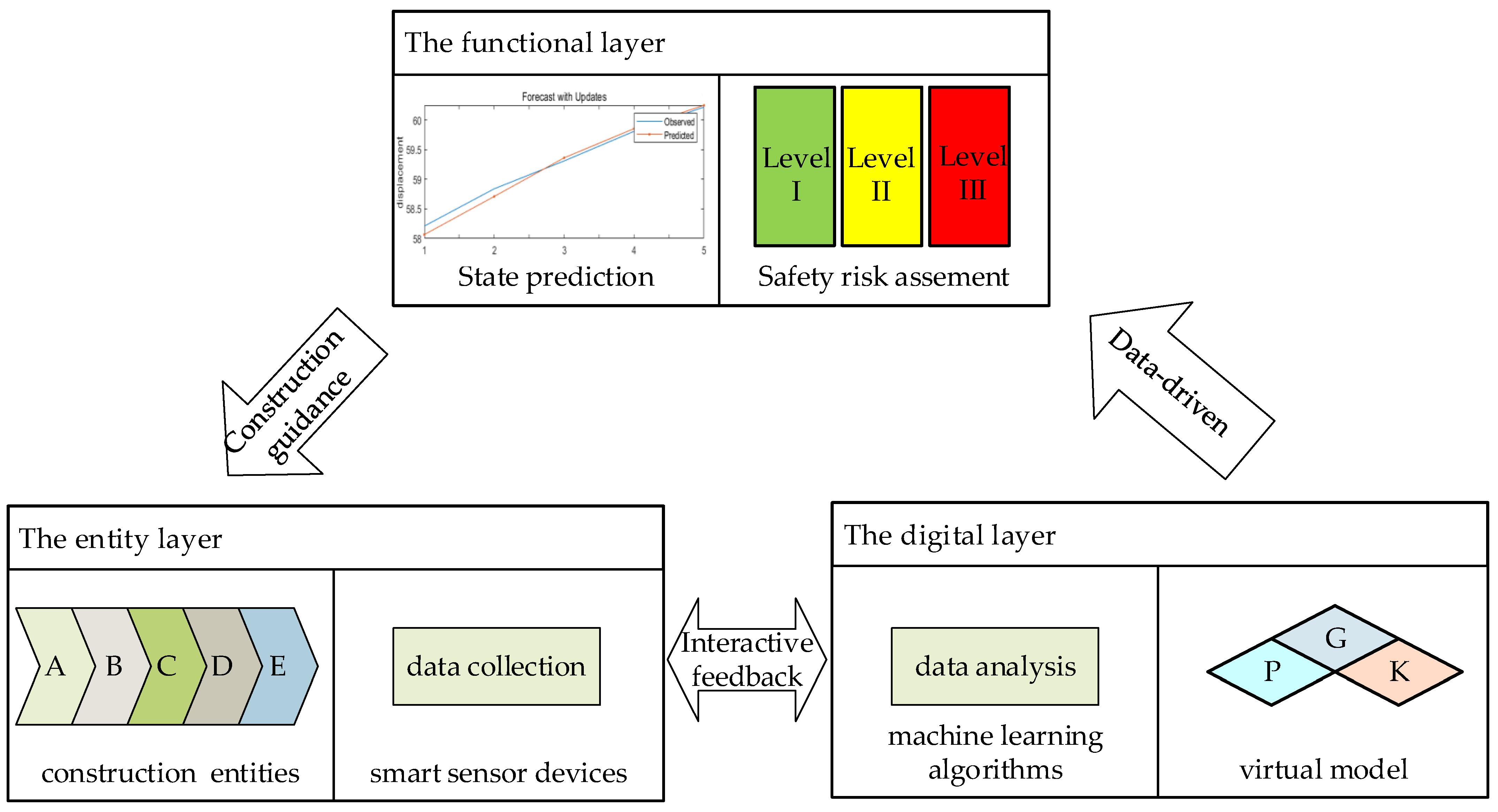
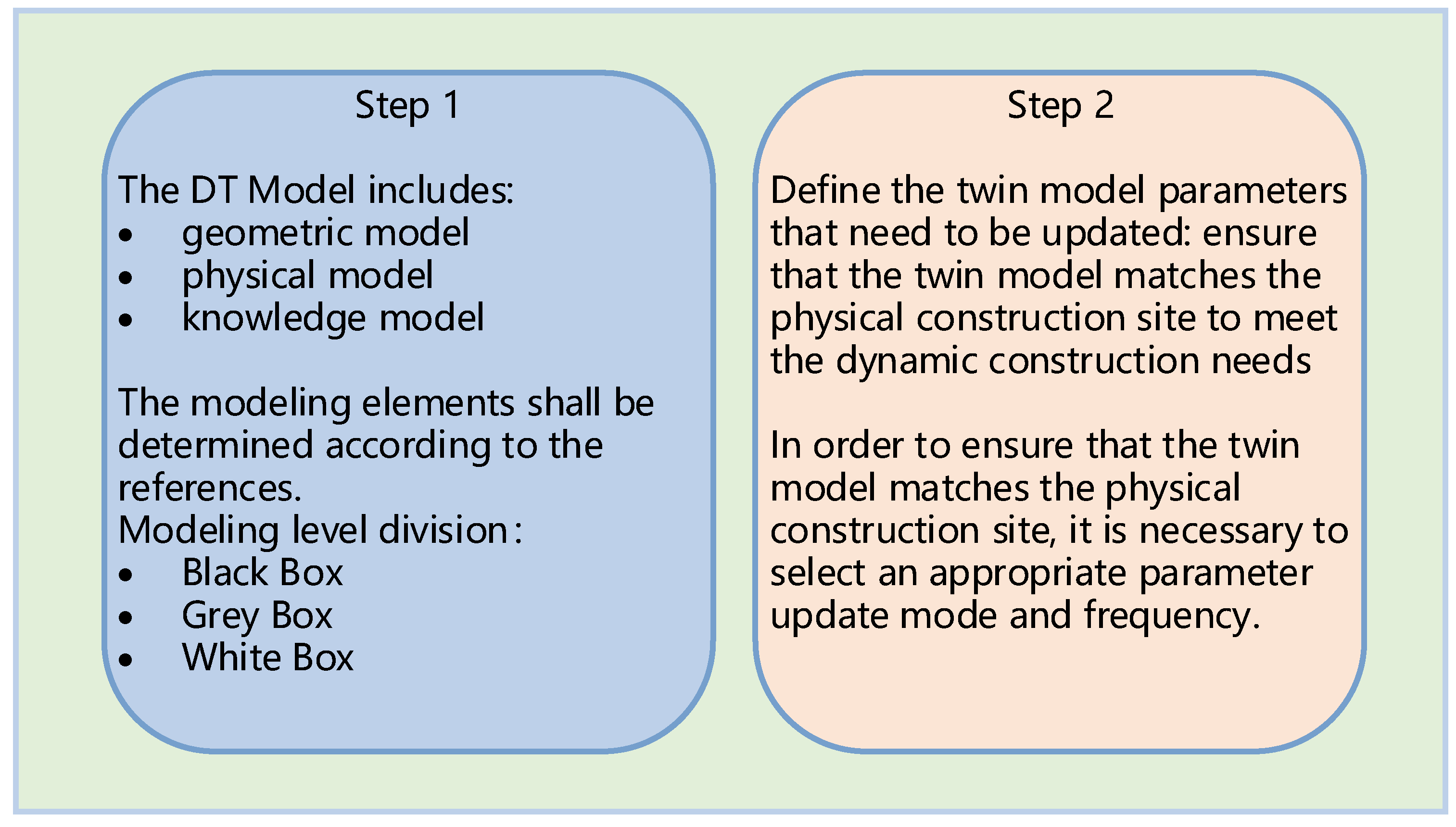
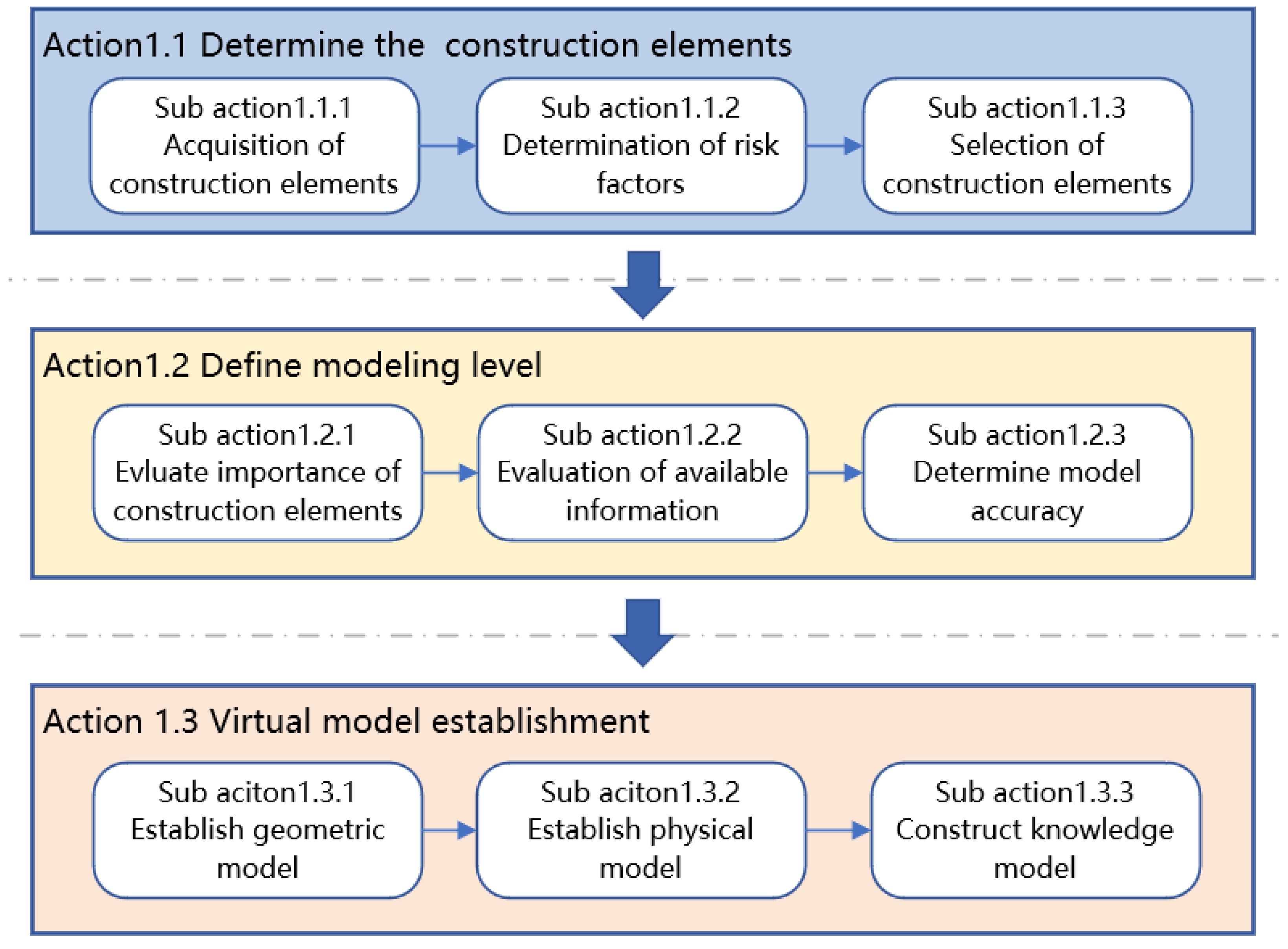
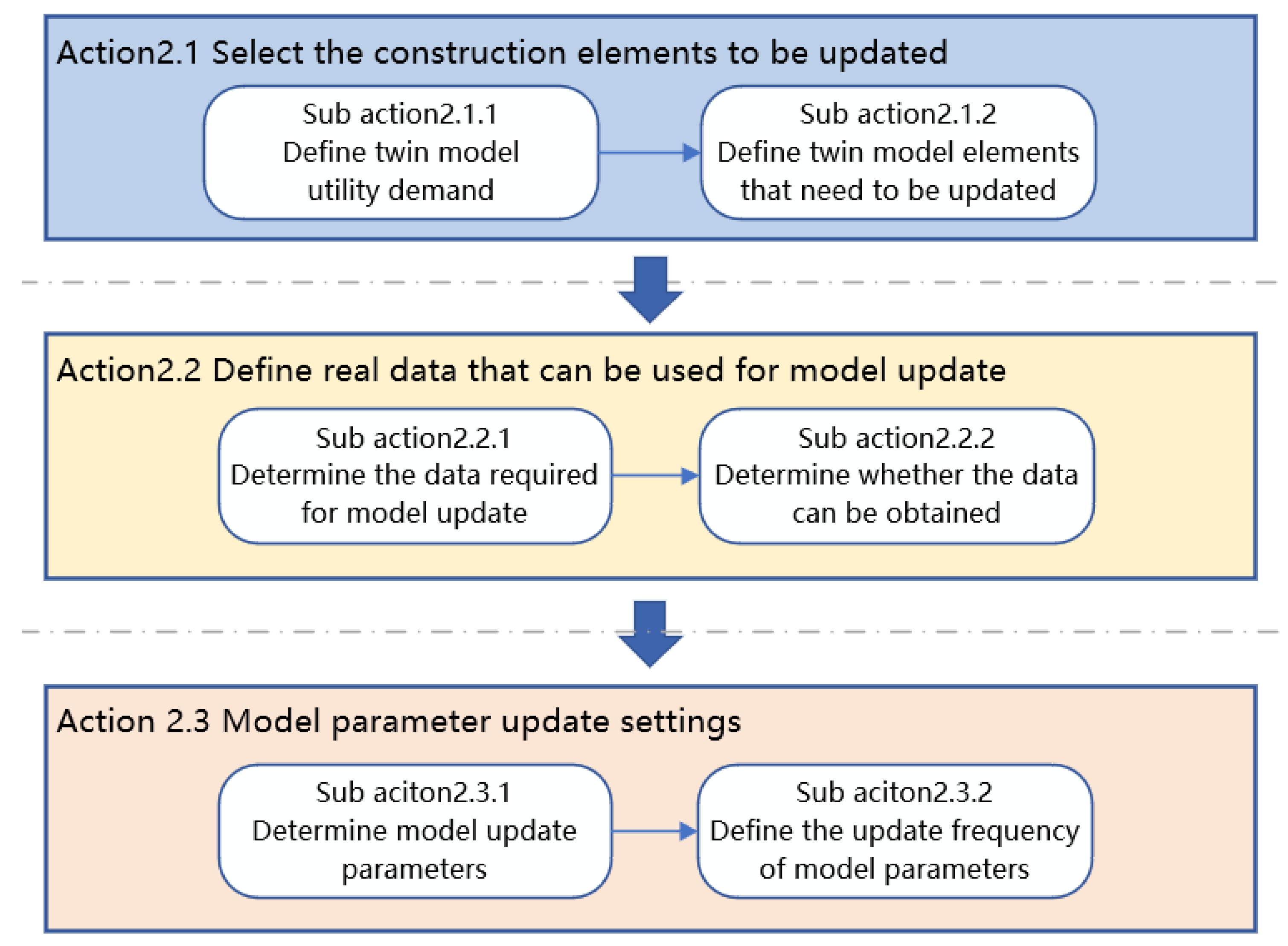
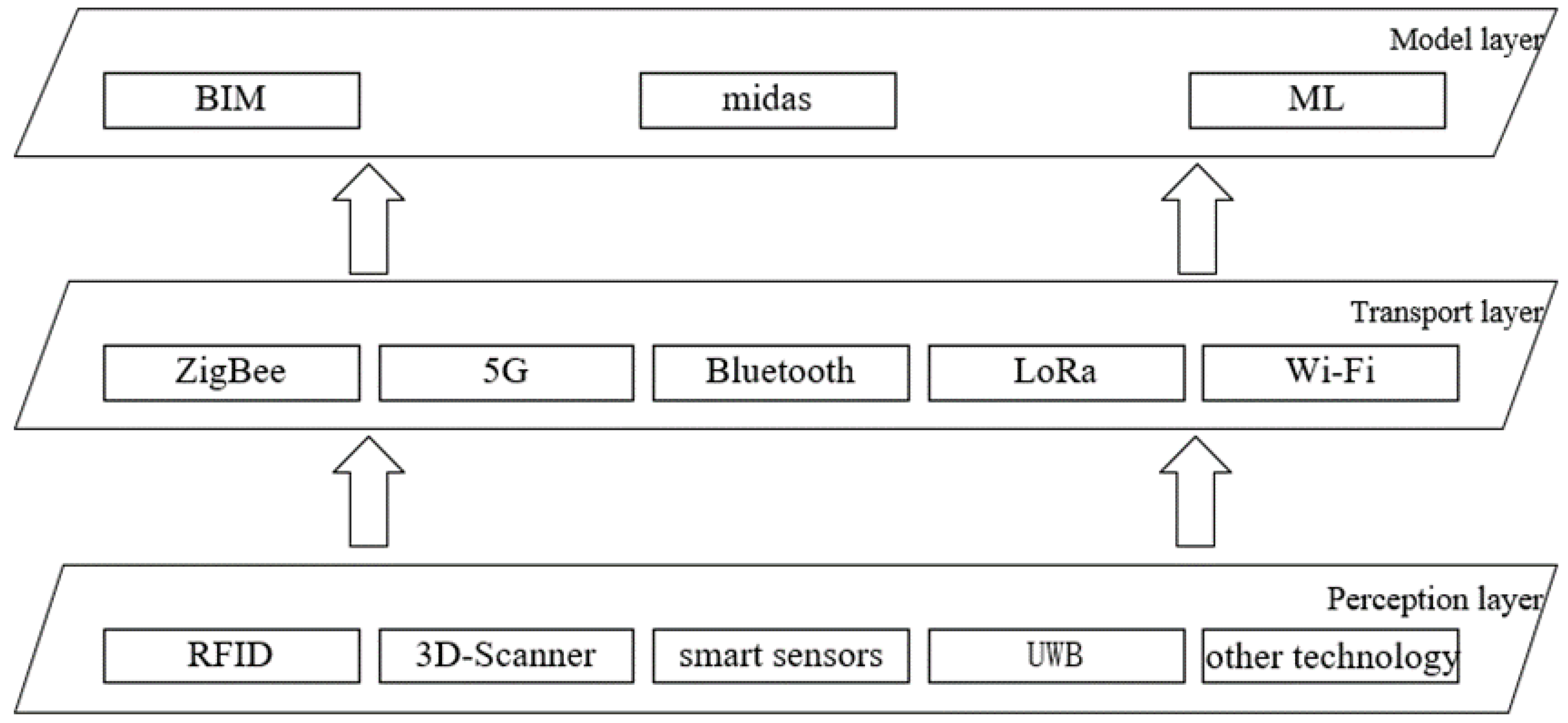
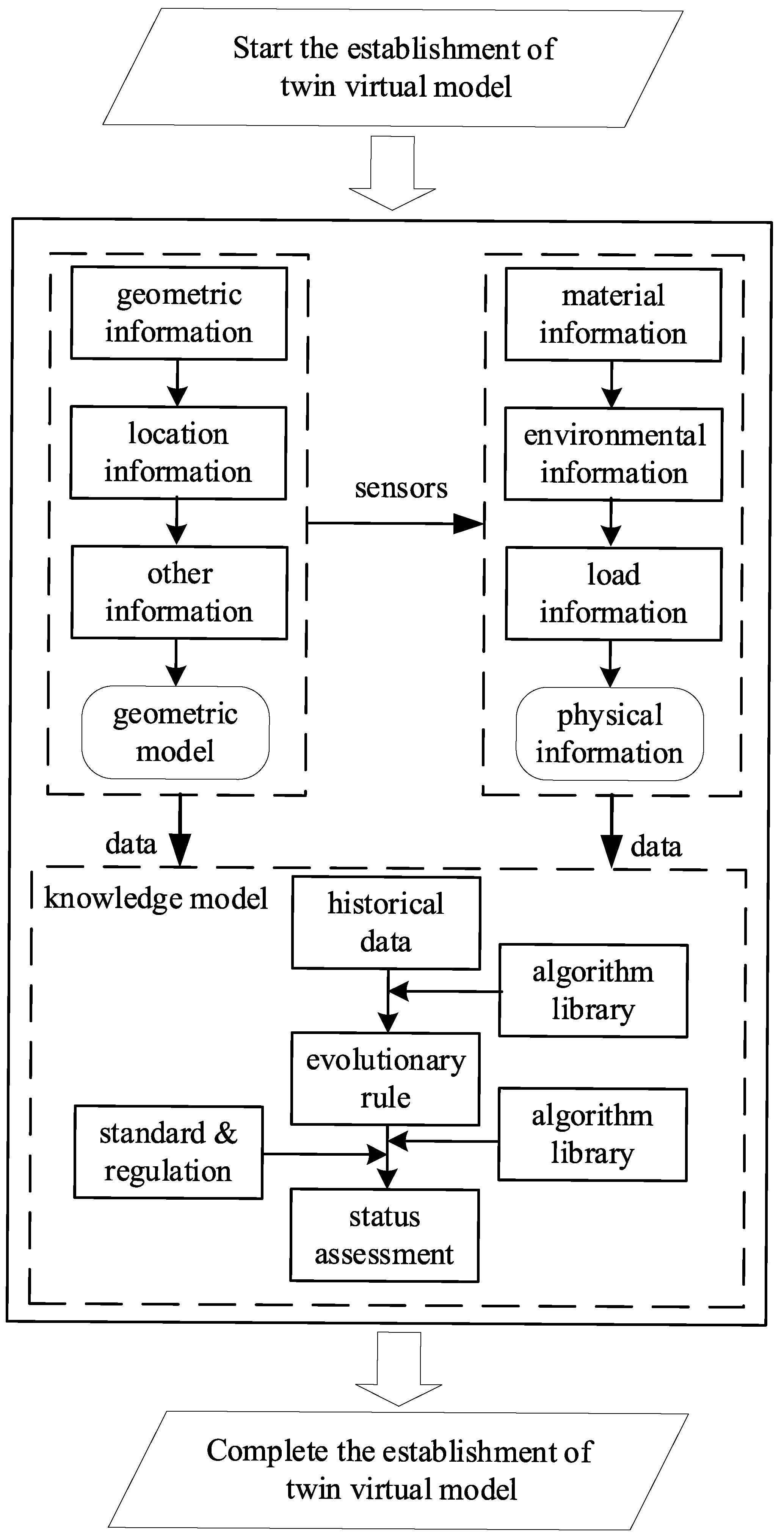
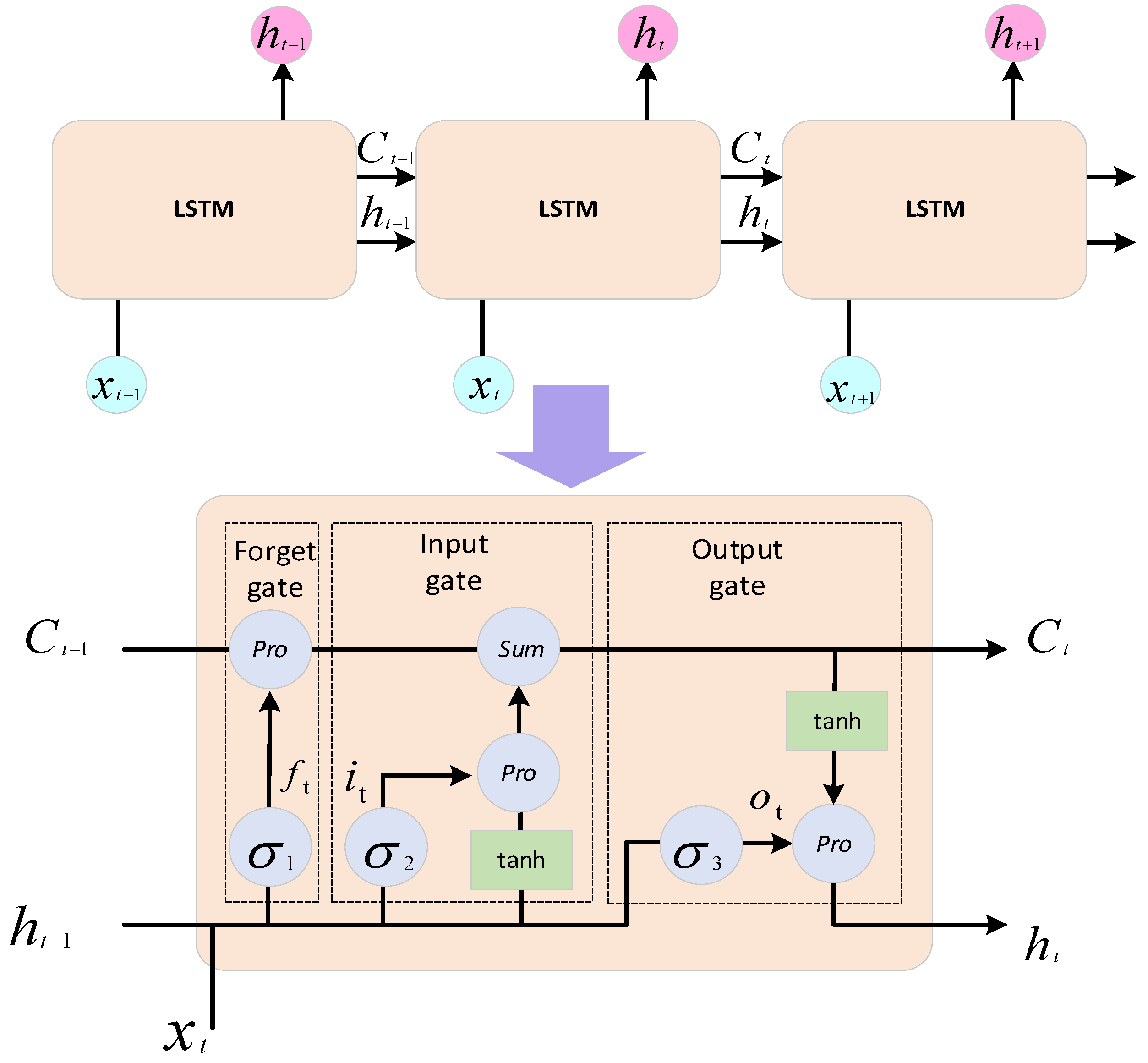
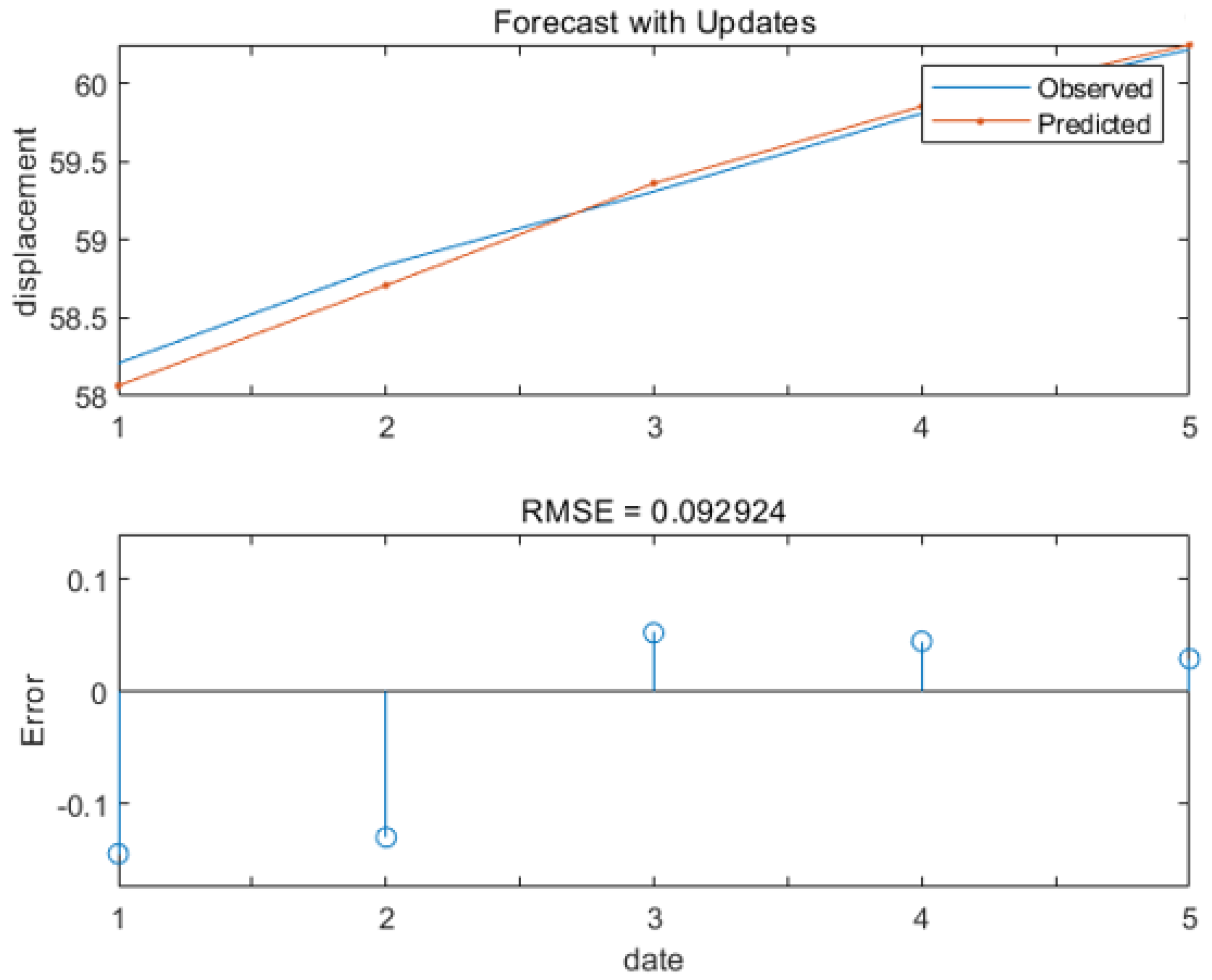
| Level | Displacement Relation/mm | Security Status |
|---|---|---|
| I | normal | |
| II | reinforcement | |
| III | special treatment |
Publisher’s Note: MDPI stays neutral with regard to jurisdictional claims in published maps and institutional affiliations. |
© 2022 by the authors. Licensee MDPI, Basel, Switzerland. This article is an open access article distributed under the terms and conditions of the Creative Commons Attribution (CC BY) license (https://creativecommons.org/licenses/by/4.0/).
Share and Cite
Zhao, Y.; Wang, N.; Liu, Z. An Established Theory of Digital Twin Model for Tunnel Construction Safety Assessment. Appl. Sci. 2022, 12, 12256. https://doi.org/10.3390/app122312256
Zhao Y, Wang N, Liu Z. An Established Theory of Digital Twin Model for Tunnel Construction Safety Assessment. Applied Sciences. 2022; 12(23):12256. https://doi.org/10.3390/app122312256
Chicago/Turabian StyleZhao, Yuhong, Naiqiang Wang, and Zhansheng Liu. 2022. "An Established Theory of Digital Twin Model for Tunnel Construction Safety Assessment" Applied Sciences 12, no. 23: 12256. https://doi.org/10.3390/app122312256
APA StyleZhao, Y., Wang, N., & Liu, Z. (2022). An Established Theory of Digital Twin Model for Tunnel Construction Safety Assessment. Applied Sciences, 12(23), 12256. https://doi.org/10.3390/app122312256







